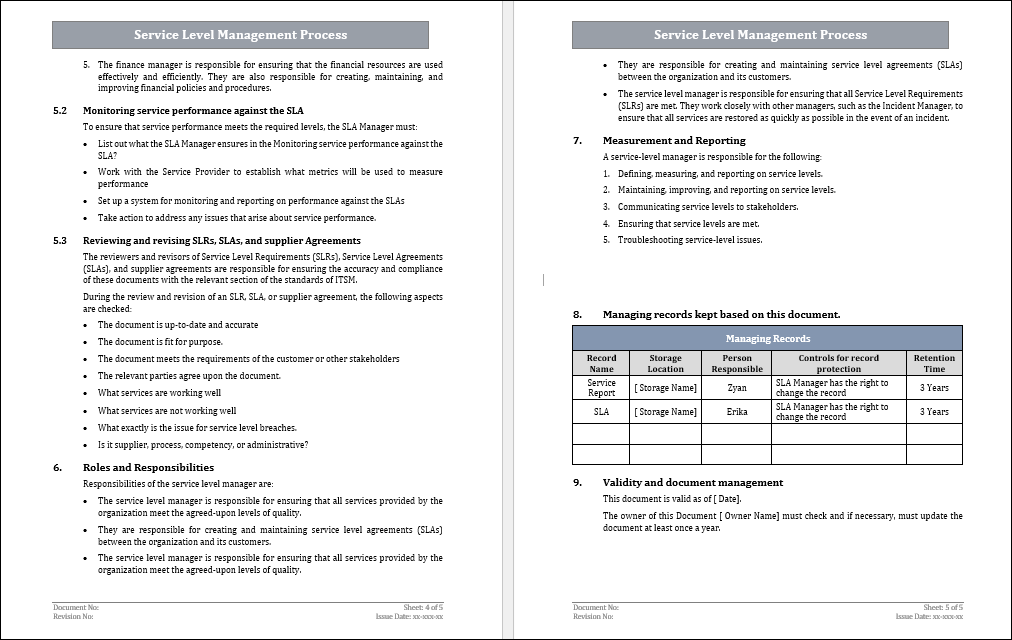Service Level Management Process Template
Introduction
The Service Level Management (SLM) Process Template in IT Governance is a systematic framework for efficiently managing and optimising the quality and delivery of IT services inside an organisation. It describes the major components and actions associated with establishing, monitoring, and improving service levels, including Service Level Agreements (SLAs), performance measurements, and continuous improvement methodologies. This template offers organisations a methodical approach to defining, measuring, and meeting service expectations, guaranteeing alignment with business objectives and promoting a proactive and responsive IT environment. It is an important tool for standardising service management procedures, improving communication between IT and business stakeholders, and ultimately contributing to the success of the IT Governance framework.

Purpose Of A Service Level Management Process Template
The major goal of a Service Level Management (SLM) Process Template in IT Governance is to create a standardised and methodical approach to controlling service levels within an organisation. By offering a standardised framework, the template provides consistency and clarity while defining, monitoring, and improving service standards. It serves as a thorough reference, describing important components such as Service Level Agreements (SLAs), performance indicators, and communication protocols. This standardisation promotes shared knowledge among stakeholders, both inside the IT department and throughout the organisation, thereby aligning IT services with business objectives.
The Service Level Management Process Template is a strategic tool that improves communication and collaboration between IT and business departments. It enables organisations to establish explicit expectations for service performance, responsiveness, and availability, resulting in a more open and accountable partnership. The template enables organisations to discover and manage issues proactively by monitoring and reporting on a regular basis, ensuring that IT services continually meet or exceed the set service levels.
Key Components Of Service Level Management Process Template
1.Service Definition:
- Clearly describe and document the IT services offered by the organisation.
- Explain the scope, features, and functionality of each service.
2. Service Level Agreements (SLAs):
- Set measurable and agreed-upon service levels for each designated service.
- Determine key performance indicators (KPIs), response times, and availability targets.
3. Service Level Objectives (SLOs):
- Set explicit and quantifiable targets that are in line with SLAs.
- Set acceptable performance levels for many areas of each service.
4. Service Level Indicators (SLIs):
- Determine the measurements and criteria used to assess the performance of services.
- Define how to collect and interpret SLI-related data.
5. Monitoring and Measurement:
- Implement processes and technologies for monitoring service performance in real time.
- Create a system for collecting and assessing relevant data to ensure SLA compliance.
6. Reporting and Communication:
- Define reporting mechanisms for communicating service performance data to stakeholders.
- Establish communication channels to keep IT and business stakeholders informed of service levels.
7. Review and Improvement:
- Implement regular reviews of SLAs, SLOs, and SLIs to ensure their continuous relevance.
- Create plans for continual improvement based on performance feedback and evolving business requirements.
Implementing the Service Level Management Process Template
Step 1: Needs Assessment
- Conduct a detailed assessment to determine the organization's particular requirements and goals for implementing SLM.
- Understand the current IT service landscape, stakeholder expectations, and regulatory compliance requirements.
Step 2: Stakeholder Engagement
- Incorporate important stakeholders, such as IT teams, business units, and customers, into the SLM implementation process.
- Gather input and feedback to ensure that the SLM procedures are consistent with the organization's overall goals.
Step 3: Customization of the Template
- Customise the SLM Process Template to meet the specific demands and characteristics of your organisation.
- Customise SLAs, SLOs, and SLIs to reflect the nature of the IT services supplied and business requirements.
Step 4: Integration with IT Governance Framework
- Align SLM processes with the organization's current IT governance framework, such as ITIL or COBIT.
- Maintain consistency and integration with other IT processes, including incident management, change management, and capacity planning.
Step 5: Communication and Training
- Share the SLM implementation strategy with all key parties.
- Provide training sessions to IT and business teams involved in service delivery, emphasising the value of SLM and how to follow the stated processes.
Conclusion
The Service Level Management (SLM) Process Template is an important tool in IT governance because it provides an organised framework for defining, monitoring, and improving the quality of IT services. This template not only standardises processes, but it also acts as the foundation for aligning IT services with organisational goals and consumer expectations. The multifaceted components within the template, including Service Level Agreements (SLAs), monitoring mechanisms, and continuous improvement strategies, collectively contribute to a proactive and responsive IT environment. The implementation of the SLM Process Template brings about tangible benefits, such as increased transparency, improved communication between IT and business stakeholders, and a heightened ability to meet or exceed service expectations.


